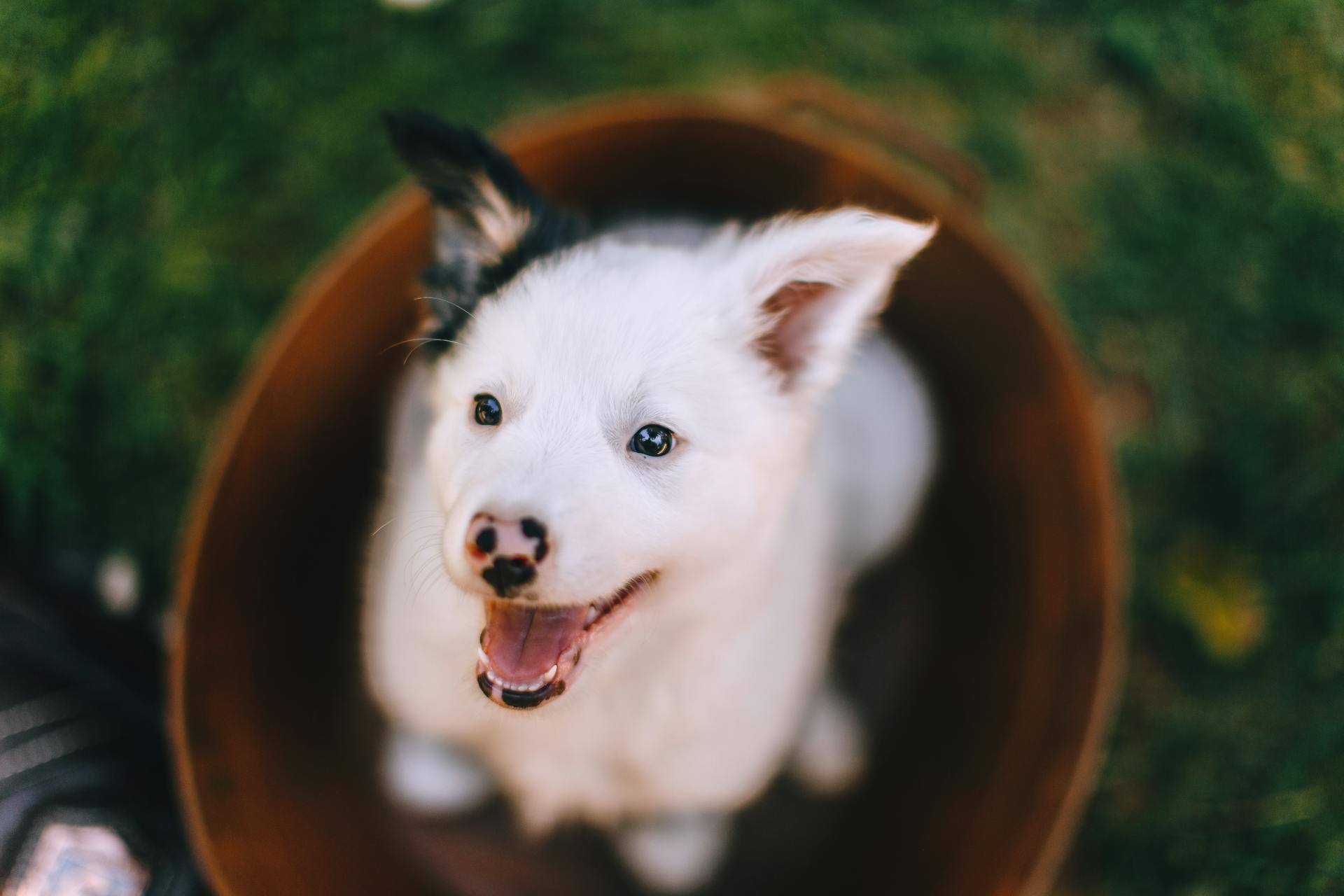
Mixed breed dogs can stop growing at different times, depending on their breed mix and size. Generally, small breeds stop growing between 6 to 12 months, while medium and large breeds can take up to 18 months to 2 years.
Small breeds, like the Poodle or Chihuahua, tend to reach full size quickly. They often stop growing between 6 to 9 months old, with some breeds finishing their growth as early as 5 months.
A fresh viewpoint: Breeds of Small Black Dogs
Dog Growth and Development
Dog growth and development is a complex process that varies depending on several factors. Puppies, regardless of breed, are considered adult dogs when they turn 1 year old, but it can take up to 2 years for them to be fully grown, both physically and emotionally.
Puppy growth rates can be influenced by breed, genetics, and gender. For example, larger breeds take almost twice as long to reach adult size as smaller breeds. Toy and small dog breeds will have almost completed their growth by 6 months, while giant breed puppies are likely to only be around half of their adult weight at this age.
According to the American Kennel Club (AKC), small breeds are about 75% fully grown by 6 months, medium breeds are about 66% fully grown, and large breeds are about 60% fully grown. Here's a rough estimate of growth rates by breed size:
Keep in mind that these are approximate growth rates, and individual puppies may vary.
Puppy Growth Timeline
Puppies grow at an incredible rate, and understanding their growth timeline can be a great help to new dog owners. Small dog breeds typically finish growing between 6 to 8 months of age, while medium breeds may take slightly longer, reaching their full size around 12 months.
After 6 months, toy and small dog breeds have almost completed their growth, but larger breeds will still be growing. A medium to large breed puppy may be around two-thirds of their full adult weight after 6 months.
Here's a rough idea of what to expect at different ages:
- By 6 months, small breeds are about 75% fully grown, while medium breeds are around 66% and large breeds are about 60%.
- By 9 months, small breeds are about 90% grown, medium breeds are 85%, and large breeds are 75%.
- By 12 months, small breeds are 100% fully grown, medium breeds are 95%, and large breeds are 85%.
- By 15 months, medium breeds are 100% grown, and large breeds are 95%.
- By 18 months, large breeds are 100% fully grown.
Remember, every dog is different, and their growth rate can be influenced by factors such as their breed, diet, and overall health.
Exercising Puppies Safely
Exercise is crucial for puppies, but it's essential to do it safely to avoid harming their developing bones and joints. Puppies should not do road work or jogging until they're at least 14 to 18 months old.
Large and giant breeds are particularly vulnerable to excessive exercise, which can cause long-term damage. Dr. Klein warns that jogging can be extremely detrimental to their bones and joints.
Instead of high-impact activities, walk your puppy on softer surfaces like grass or sand for short distances of a quarter-mile or less. This will help prevent injuries and support healthy growth.
Remember, every puppy is different, but with moderation and the right approach, you can help your furry friend grow strong and healthy.
Readers also liked: When Do Dogs Stop Being a Puppy
Factors Affecting Growth
Breed plays a significant role in determining a dog's growth rate, with purebred standards providing weight and height ranges to reference.
Genetics also come into play, as they tell us more about the dog's expected size, including the size of the parents and other puppies in the litter.
A unique perspective: How to Change Your Dog's Breed on Paperwork?
Males tend to be larger than females, so if you have a female pup, expect her to be on the lower end of the spectrum for her breed.
Puppy growth times vary depending on their size, with small dogs reaching full growth in as little as 6-12 months, while large breeds take almost twice as long, almost 2 years.
Here's a rough estimate of growth rates for different sizes of dogs:
For mixed-breed dogs, determining their growth rate can be a bit tricky, especially for younger puppies between 6 and 10 weeks of age.
Growth Factors
Puppies grow at different rates depending on several factors. One key factor is breed, as purebred standards give us weight and height ranges to reference.
Genetics also play a significant role in determining a puppy's growth rate. Knowing how big or small the parents were, what the other puppies in the litter grew to, and more can provide valuable information.
Gender is another factor to consider, as males tend to be larger than females. This means a girl pup may be on the lower end of the spectrum for her breed if she's a purebred.
Here's a rough breakdown of the growth rates for different sizes of dogs:
Dogs of different sizes grow at different rates, with large breeds taking almost twice as long as small dogs to reach their full adult size.
Do Large Dogs Stop Growing?
Large dogs can stop growing anywhere between 10 to 18 months of age, but this can vary depending on the breed. Some very large or giant breeds, like mastiffs, may take up to 24 months to fully develop.
Typically, a large dog breed will reach its full height by the 16 month mark, but it's essential to remember that every dog is different. I've seen some friends' dogs take longer to mature, and it's not uncommon for them to still be filling out at 18 months.
A medium to large breed puppy may be around two-thirds of its full adult weight after 6 months, but larger breeds will still be growing at this age. This means they'll likely continue to put on weight and gain height until they reach their full adult size.
Factors like breed, sex, and diet can all impact a dog's growth rate, so it's crucial to provide them with a balanced diet full of essential minerals and protein. This will help them grow strong and healthy, and reach their full potential.
Mixed-Breed Dogs
Mixed-breed dogs can be a bit tricky to determine their growth rate, as Dr. Klein mentions that it's a bit of a guessing game when dealing with a dog of unknown heritage. This is especially true for younger puppies between 6 and 10 weeks of age.
A helpful hint is that if you run your hands down a dog's rib cage and you can still feel the 'knobs' of the ribs, that dog will probably continue to grow in height, says Dr. Klein. These 'knobs' are the growth plates of the ribs that are still developing.
Mixed-breed dogs, like all dogs, will stop growing in height eventually, but the exact time frame can vary. It can take anywhere between 6 and 24 months for a dog to stop growing in height.
Male mixed-breed dogs tend to take slightly longer to reach their full growth than females, as they tend to be taller.
Determining Maturity
Small breed dogs will typically finish growing between 6 to 8 months of age, while medium breeds may take slightly longer, reaching their full size around 12 months.
Feeling the ribs and growth plates can sometimes be used to help indicate if a puppy is fully grown. If you run your hands down your dog's rib cage and you can still feel knobs at the edge of the bones, these are the growth plates that are still hardening suggesting that your puppy still has more growing to do.
Large dog breeds will typically stop growing anywhere between 10 to 18 months of age, but some breeds like mastiffs may take up to 24 months to fully develop.
Suggestion: When Do Dogs Get Out of Their Puppy Stage
How to Tell It's Grown Up

Telling if a puppy is fully grown can be tricky, but there are a few ways to gauge their maturity.
You can't rely on the size of their paws, as this is just a myth. Your vet can check if they have all their adult teeth, but this usually happens by the age of 6-7 months.
Feeling the ribs can be a helpful indicator of a puppy's growth. If you run your hands down their rib cage and feel knobs at the edge of the bones, these are the growth plates that are still hardening, suggesting they still have more growing to do.
Even when bones are fully developed, a puppy will continue to develop fat and muscle, so don't rely solely on physical appearance.
Small Dogs Reach Maturity
Small dogs typically finish growing when they're between 6 to 8 months of age. This can vary depending on the breed, but most small dog breeds will reach their full size during this time.
Small breeds are any dogs under 25 lbs when fully grown, and medium breeds range between 25 to 50 lbs. A medium breed may take slightly longer to reach their full size, around 12 months.
Your puppy's most rapid growth and development will take place between birth and 6 months of age. After 6 months, toy and small dog breeds will have almost completed their growth.
Feeling the ribs and their growth plates can sometimes be used to help indicate if a puppy is fully grown. If you run your hands down your dog's rib cage and you can still feel knobs at the edge of the bones, these are the growth plates that are still hardening, suggesting that your puppy still has more growing to do.
Sources
- https://www.dogsnaturallymagazine.com/when-do-dogs-stop-growing/
- https://www.akc.org/expert-advice/health/when-does-my-puppy-finish-growing/
- https://www.dogster.com/lifestyle/when-do-puppies-stop-growing
- https://www.thelabradorsite.com/labrador-puppy-growth-faq/
- https://wellbeloved.com/blogs/caring-for-puppies/tagged-puppy-health-when-do-dogs-stop-growing
Featured Images: pexels.com


